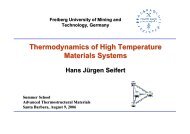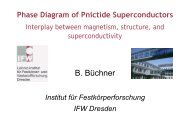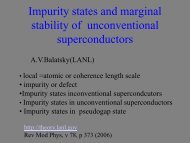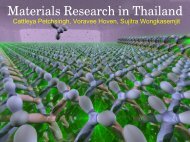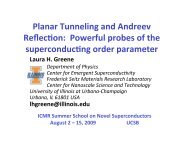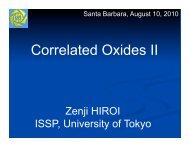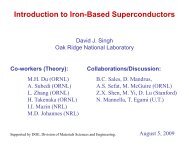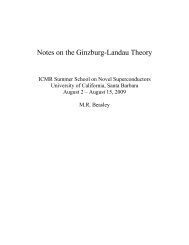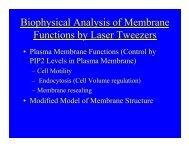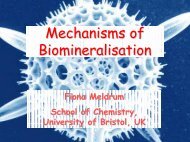download PDF - International Center for Materials Research
download PDF - International Center for Materials Research
download PDF - International Center for Materials Research
You also want an ePaper? Increase the reach of your titles
YUMPU automatically turns print PDFs into web optimized ePapers that Google loves.
© Air Products and Chemicals, Inc, 2006
Hydrogen Storage and Delivery in a<br />
Liquid Carrier Infrastructure<br />
Guido P. Pez, Alan C. Cooper, Hansong Cheng,<br />
Bernard A. Toseland and Karen Campbell<br />
Corporate Science and Technology <strong>Center</strong>,<br />
Air Products and Chemicals, Inc., Allentown, PA<br />
18195<br />
© Air Products and Chemicals, Inc, 2006
Air Products’ Hydrogen Experience<br />
‣ World leader in industrial hydrogen<br />
supply<br />
• Own, operate, and distribute<br />
hydrogen – Americas, Europe, Asia<br />
• Operate over 60 plants, 7 pipelines,<br />
produce over 1.25 million tons/year<br />
‣ Demonstration leader in hydrogen<br />
fueling infrastructure<br />
• 30 fueling stations - Americas,<br />
Europe, Asia<br />
• Technology advances include<br />
mobile fueling, underground liquid<br />
storage, dispensing, onsite<br />
generation, storage<br />
• Global safety leader<br />
3<br />
© Air Products and Chemicals, Inc, 2006
Hydrogen Storage Methods<br />
‣ Physical methods<br />
• compression (350, 700 bar)<br />
• liquid hydrogen (20 K)<br />
‣ Physical adsorption (H-H bond remains<br />
intact)<br />
• adsorption on high surface area<br />
materials<br />
• activated carbon, carbon<br />
nanotubes, zeolites<br />
‣ Chemisorption (H-H bond broken)<br />
• metal hydrides (LaNi 5 , FeTi)<br />
• advanced hydrides (NaAlH 4 )<br />
• “chemical hydrides” - hydrolysis<br />
(NaBH 4 ), benzene +3H 2<br />
cyclohexane<br />
Hydrogen storage is one of the key technical barriers to<br />
the use of hydrogen as an energy carrier<br />
4<br />
© Air Products and Chemicals, Inc, 2006
An Integrated Production, Storage and<br />
Delivery of Hydrogen – Using Reversible<br />
Liquid Carriers (LQ*H 2 )<br />
2-Way liquid<br />
transport<br />
LQ*H 2<br />
At a H 2<br />
Source<br />
Site:<br />
cat.<br />
H 2<br />
+ LQ* → LQ*H 2<br />
using existing<br />
liquid fuels<br />
infrastructure<br />
Station<br />
LQ*<br />
LQ*H 2<br />
Dehydrogenation<br />
H 2<br />
LQ*<br />
On Board hydrogen<br />
storage, delivery<br />
H 2<br />
(HP)<br />
cat.<br />
Carrier Liquid (LQ*)<br />
Source<br />
LQ*H 2<br />
→ LQ*+H 2<br />
On Site H 2<br />
delivery<br />
5<br />
© Air Products and Chemicals, Inc, 2006
Approach:<br />
An off-board regenerable liquid carrier <strong>for</strong><br />
vehicles and stationary H 2<br />
gas delivery<br />
LQ*H 2<br />
LQ = liquid carrier<br />
∆ = heat<br />
Liquid<br />
Storage Tank<br />
LQ<br />
Catalytic<br />
Converter<br />
∆<br />
Heat Exchange<br />
∆<br />
Fuel Cell<br />
H 2<br />
‣ Con<strong>for</strong>mable shape liquid<br />
tank with design to<br />
separate liquids; 22.5<br />
gallons <strong>for</strong> 5 kg hydrogen<br />
at 6 wt. % and unit density<br />
‣ Heat exchange reduces<br />
the vehicles’ radiator load<br />
by ca. 40% (<strong>for</strong> ∆H of 12<br />
kcal/mol H 2 and 50% FC<br />
efficiency)<br />
LQ*H 2<br />
+ heat (∆H)<br />
Catalyst<br />
P < 10 atm.<br />
P > 50 atm.<br />
Catalyst<br />
LQ + H 2<br />
Maximum energy efficiency: by (a) recovering the<br />
exothermic (-∆H) of hydrogenation and (b) utilizing the<br />
waste heat from the power source to supply the ∆H <strong>for</strong><br />
the endothermic dehydrogenation.<br />
6<br />
© Air Products and Chemicals, Inc, 2006
Partial List of Organic “Liquid Carrier”<br />
Per<strong>for</strong>mance Criteria<br />
H<br />
H<br />
H<br />
H<br />
Hydrogenation<br />
+ 3 H 2 Catalyst<br />
Dehydrogenation<br />
H<br />
of >350 ºC<br />
H<br />
Benzene (gas) ∆Hexp.: -16.4 Kcal/mol H 2<br />
H<br />
H<br />
H<br />
H<br />
H H<br />
H<br />
H<br />
H<br />
H<br />
H<br />
H<br />
Cyclohexane (gas)<br />
‣ Optimal heat of dehydrogenation (ΔH = 10-13 kcal/mole H 2 ), enabling the<br />
catalytic dehydrogenation in an all-liquid state at temperatures ( 300 o C), enabling the dehydrogenation in small compact<br />
reactor systems onboard vehicles and reducing exposure to vapors<br />
‣ Low toxicity and environmental impact<br />
‣ Clean catalytic hydrogenation and dehydrogenation, enabling multiple cycles<br />
of use with no significant degradation of the molecule<br />
‣ Manufacture of the liquid carriers from low cost, source raw materials.<br />
7<br />
© Air Products and Chemicals, Inc, 2006
Prior Art on Organic Liquid Carriers<br />
Hydrogen and energy storage 1 by a reversible catalytic hydrogenation<br />
of naphthalene C 10<br />
H 8<br />
to decalin C 10<br />
H 18<br />
(a “liquid organic hydride” 2 )<br />
+5H 2<br />
-5H 2<br />
∆H o =-15.1 kcal/mole H 2<br />
High conversion of C 10<br />
H 18<br />
in membrane reactor at ~320 o C 2<br />
Efficient H 2<br />
evolution from C 10<br />
H 18<br />
from 195 o C to 400 o C under<br />
“wet-dry multiphase” 3 or “superheated liquid film” conditions 4-5 .<br />
(Both are two-phase liquid/vapor processes.)<br />
Condenser<br />
<strong>for</strong> C 10 H 8<br />
H 2<br />
Catalyst (Temp >b.p.)<br />
Heater<br />
8<br />
1. E. Newson Int,. J. Hydrogen Energy, 23 905 (1998) 2. R. O. Loufty et al, Proc. Of Int. H 2 Energy Forum,<br />
3. N. Kariya, M. Ichikawa et al, Appl. Cat A, 233, (2002), 91-102 (2000) 335-340<br />
5. S. Hodoshima and Y. Saito, Int. J. Hy Energy, 28, (2003), 197-204 4. S. Hodoshima et al, Suiso Enerugi Shisutemu 25,<br />
(2000), 36-43<br />
© Air Products and Chemicals, Inc, 2006
Fundamental Energetics <strong>for</strong><br />
Containing Hydrogen<br />
K<br />
For H 2 (gas) + carrier H 2 (contained) equilibrium:<br />
∆G = ∆H - T ∆S = RTlnK<br />
For containing hydrogen in a spontaneous prcess:<br />
a) For carrier bound, but intact molecular H 2 (physisorption)<br />
(-ΔH)
Observed and Desirable<br />
H 2 -Containment Enthalpies (-∆H, kcal/mole H 2 )<br />
0<br />
1 2 5 7 7.3 8.8 9.8 11.1 13 15 17.7 18.7<br />
graphite/<br />
H 2 77K<br />
SW carbon<br />
nanotubes 4<br />
C 24 K 5<br />
LaNi 5 H 1<br />
(1.8 atm, 25°C)<br />
NaAlH 4<br />
diss.2<br />
TiFe 0.8 Ni 0.2 H 0.7<br />
(0.1 atm 25°C)<br />
Desired (-∆H) ranges : 5-7 kcal/mole H 2 -Strong Physisorption<br />
: 7-13 kcal/mole H 2 – Weak to Moderate Chemisorption<br />
: 10-13 kcal/mole H 2 – optimal <strong>for</strong> liquid carrier<br />
Note: Lower Heating Value <strong>for</strong> H 2 (LHV) = 57 kcal/mole<br />
Liquid Carrier<br />
Na 3 AlH 6 diss. 2<br />
(5.6 wt% total)<br />
1. G. Sandrock, J. of Alloys and Compounds 293-295 (1999) 877<br />
2. B. Bogdanovic, G. Sandrock, MRS Bulletin 2002, 712<br />
3. W. Peschka, “Liquid Hydrogen Fuel of the Future” Springer-Verlag p. 65<br />
4. M. Haas et al., J. of <strong>Materials</strong> <strong>Research</strong> 20 (12) 3214 (2005)<br />
5. K. Watanabe et al., Proc. R. Soc. London A333, 51 (1973)<br />
Napthalene (C 10 H 8 )<br />
decalin (C 10 H 18 )<br />
~7.4 wt%<br />
20<br />
MgH 2<br />
1 atm ~290°C<br />
~7.5 wt%<br />
H 2 liquefaction<br />
work 3<br />
© Air Products and Chemicals, Inc, 2006
Enthalpies of Hydrogenation as Function<br />
of N Substitution<br />
Desirable<br />
Fused Multi-Ring Aromatics and Inclusion of N-Heteroatoms can<br />
greatly lower ∆H<br />
© Air Products and Chemicals, Inc, 2006 US and non-US patents pending
Hydrogenation/Dehydrogenation of<br />
N-Ethylcarbazole<br />
6H 2<br />
Ru / Al 2 O 3<br />
130-170 o C<br />
1000 psi H 2<br />
100 %<br />
Hcalc.= -12.4Kcal/mole H 2<br />
Hesc. = -12.2Kcal/mole H 2<br />
Capacity : 5.8 %<br />
N<br />
H 2 C CH3<br />
Pd / C<br />
200 o C<br />
H 3 C<br />
N<br />
CH 2<br />
6H 2<br />
© Air Products and Chemicals, Inc, 2006 US and non-US patents pending
Flow Measurement of Hydrogen Generation<br />
from N-ethylcarbazole<br />
(Ramp from 25 o C to 200 o C, 1 atm. H 2, ,<br />
40:1 substrate/catalyst)<br />
H2<br />
Temperature ( o C)<br />
desorbed (wt. %)<br />
GC/MS analysis after run termination showed loss of 5.7% wt. H 2<br />
13<br />
© Air Products and Chemicals, Inc, 2006
Cycling Studies<br />
Dehydrogenation: Ramp from 25 o C<br />
to 200 o C, 15 psia H 2<br />
Hydrogenation: 170 o C, 1200 psia H 2<br />
N-ethylcarbazole<br />
CH 3<br />
N<br />
Cycle 1 Cycle 2 Cycle 3<br />
Rapid hydrogenation and cycling stability<br />
14<br />
© Air Products and Chemicals, Inc, 2006
Understanding the Mechanism<br />
- 2H 2<br />
-2H 2<br />
- 2 H 2<br />
N + 2 H 2 N + 2 H 2<br />
N + 2 H 2<br />
N<br />
(11.3)* (12.4)* (12.8)*<br />
( )* : ∆H calc. (B3LYP/G-311G**) in Kcal/mol H 2<br />
∆H exp. (overall) = 12.2 kcal/mole H 2<br />
15<br />
© Air Products and Chemicals, Inc, 2006
N-ethylcarbazole Dehydrogenation:<br />
(Ramp from 25 o C to 150 o C, 15 psia H 2 )<br />
Slow catalytic dehydrogenation rate at 150 o C<br />
16<br />
© Air Products and Chemicals, Inc, 2006
Dehydrogenation Flow Reactor<br />
Test System<br />
2” Packed<br />
Bed Reactor<br />
17<br />
© Air Products and Chemicals, Inc, 2006
Packed Bed Reactor Dehydrogenation/<br />
Hydrogenation Cycling Demonstration<br />
190 o C; 0.25 ml./min/ Liquid Flow<br />
18<br />
© Air Products and Chemicals, Inc, 2006
H 2 Purity from Continuous Flow<br />
Dehydrogenation Experiments<br />
Component<br />
Hydrogen<br />
Methane<br />
Ethane<br />
Carbon Monoxide<br />
N containing compounds<br />
C3’s<br />
C4’s<br />
C5’s<br />
C6’s<br />
Mole %<br />
99.9+<br />
0.0013%<br />
0.0083%<br />
ND<br />
ND<br />
ND<br />
ND<br />
ND<br />
ND<br />
ND – Non Detectable<br />
19<br />
© Air Products and Chemicals, Inc, 2006
Illustration of Con<strong>for</strong>mers: Decalin<br />
Naphthalene<br />
E<br />
N<br />
T<br />
H<br />
A<br />
L<br />
P<br />
Y<br />
(kcal/mole)<br />
∆ H o cis = -76.40 ∆ H o trans = -79.59<br />
H<br />
H<br />
cis-decalin<br />
0<br />
trans-decalin<br />
-3.19<br />
H<br />
H<br />
20<br />
© Air Products and Chemicals, Inc, 2006
Perhydro-Nethylcarbazole<br />
Con<strong>for</strong>mers<br />
At B3LYP/G-311G** level<br />
∆E =<br />
0<br />
21<br />
∆E = 2.6 kcal/mol ∆E = 8.6 kcal/mol ∆E = 14.5<br />
© Air Products and Chemicals, Inc, 2006 kcal/mol
Flow Measurement of Hydrogen Generation from<br />
N-ethylcarbazole: Kinetic versus Thermodynamic Con<strong>for</strong>mers<br />
20% metastable<br />
con<strong>for</strong>mers – from<br />
170 o C hydrogenation<br />
80% metastable<br />
con<strong>for</strong>mers - from<br />
120 o C hydrogenation<br />
© Air Products and Chemicals, Inc, 2006<br />
US and non-US patents pending
Increasing Capacity: Hydrogen<br />
Generation from Phenylenecarbazole<br />
GC/MS analysis after run termination showed loss of 6.2 % wt H 2<br />
23<br />
Theory is 6.9% wt H 2<br />
© Air Products and Chemicals, Inc, 2006
No Perfect World!<br />
N<br />
Dehydrogenation<br />
N<br />
+<br />
N<br />
H<br />
80% 20%<br />
Presence of secondary amine confirmed by alkylation and by GC/MS<br />
Second fused five-membered rings can cause strain.<br />
24<br />
© Air Products and Chemicals, Inc, 2006
Phenanthrolene Dehydrogenation<br />
N<br />
N<br />
Theoretical: 7.2% wt.<br />
% H 2<br />
and 69 g H 2<br />
/L<br />
25<br />
We have demonstrated a 7+ wt. % reversible capacity with<br />
this new carrier – a 1.5 wt. % increase over N-ethylcarbazole<br />
© Air Products and Chemicals, Inc, 2006
Oxygen-containing Carrier<br />
O<br />
Theoretical: 6.7%<br />
wt. % H 2<br />
and 69 g<br />
H 2<br />
/L<br />
26<br />
A member of a new class of hydrogen carriers containing<br />
only oxygen heteroatoms<br />
© Air Products and Chemicals, Inc, 2006
Summary and Conclusions<br />
‣ Liquid carrier concept provides an integrated<br />
hydrogen production, delivery and on-board<br />
storage scenario.<br />
• Maximize use of existing liquids<br />
infrastructure<br />
• Safety<br />
• Energy efficiency<br />
‣ Continuing material challenges:<br />
• Optimal liquid carrier: 9 wt% <strong>for</strong> system<br />
(DOE’s 2015 target)<br />
• Optimal dehydrogenation catalysts <strong>for</strong> a<br />
compact, on-board liquid carrier H 2 gas<br />
conversion reactor<br />
27<br />
© Air Products and Chemicals, Inc, 2006
Acknowledgements<br />
Atteye H. Abdourazak<br />
Donald Fowler<br />
Aaron R. Scott<br />
Sergei Ivanov<br />
DOE Hydrogen and Fuel Cells Program<br />
28<br />
© Air Products and Chemicals, Inc, 2006
Thank you<br />
© Air Products and Chemicals, Inc, 2006
tell me more<br />
www.airproducts.com<br />
© Air Products and Chemicals, Inc, 2006



